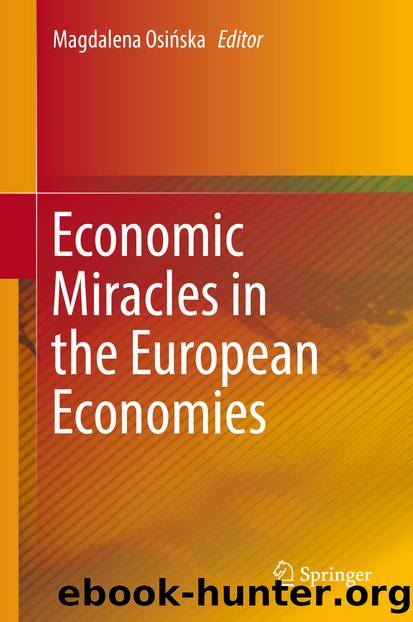Economic Miracles in the European Economies by Unknown

Author:Unknown
Language: eng
Format: epub
ISBN: 9783030056063
Publisher: Springer International Publishing
6.4 Sources of Economic Growth in Israel: Real Sector and Labor Markets
For nearly the entire first century of the Zionist endeavor, socialist, almost Bolshevik, outlook dominated both thinking and practice of economic development. The key movers in economics and politics were emigrated from Russia during the first decade of the twentieth century (the Second Aliyah) and were critically influenced by the economic philosophies that also brought about the Russian revolution of 1917. Members of the Second Aliyah developed the kibbutz movement and were the main functionaries who developed the Histadrut, the pre-state quasi-governmental, local economic umbrella organization. Founded in 1920, the Histadrut combined both a federation of labor unions, ownership, and/or virtual control of various enterprises ranging from natural monopolies (public transport, naval and air ports) to core industrial firms (Tnuva—a dairy cooperative, Kur—an industrial mega-cooperation) and public service enterprises (sick funds, health care, sports teams, and more).
Arguably, this highly centralized and politicized organization was the appropriate option for those early years. In that period, the Jewish settlement was exceedingly small, required major infrastructure and other development and had to deal with violent opposition to its mere existence. Additionally, Israel had to absorb massive immigrants relative to the size of the native Jewish population and poorly developed institutional infrastructure required for well-functioning markets (e.g., preservation of property rights) despite the existence of many necessary institutions for a modern nation.
During the first years of independence, Israel’s basic economic circumstances did not change much, with immigration now unencumbered by international geopolitics and infrastructure development, including basic housing for immigrants, still the major priority for more government control. As immigration tapered off and development progressed, forces advocating an increased role for the private sector have emerged.
This situation combined with more than a decade of macroeconomic mismanagement culminated in a major economic crisis at both the macro and micro levels. The macro situation was largely resolved by the Economic Stabilization Program of July 1985, whereby a heterodox approach of both fiscal austerity and a coordinated nominal-side “freeze” succeeded in drastically reducing rampant inflation and eliminating Israel’s massive twin deficits. At the time, there was broad awareness that returning the economy to health would require a broad range of structural reforms that would essentially transform the economy to a modern, mixed-capitalist regime.
While the basic direction and thrust of the reform process that transpired over two decades were understood, the timing and institutional details of the various segments of the reforms were not part of an overall program designed at the outset. Instead, the process was the result of initiatives undertaken by various governments and other public and quasi-public institutions as well as reactions to exogenous developments, especially the massive immigration following the collapse of the Soviet Union at the end of the 1980s and the large-scale discrediting of socialism that accompanied that traumatic event.
The first steps in real sector reform included a major change in the government policy of bailing out large, inefficient, failing enterprises (for example, ATA—a textile company, Israel Aircraft, and Tadiran) and legislated, phased-in foreign trade liberalization.
Download
This site does not store any files on its server. We only index and link to content provided by other sites. Please contact the content providers to delete copyright contents if any and email us, we'll remove relevant links or contents immediately.
Tools of Titans by Timothy Ferriss(8304)
Change Your Questions, Change Your Life by Marilee Adams(7684)
Deep Work by Cal Newport(6966)
Playing to Win_ How Strategy Really Works by A.G. Lafley & Roger L. Martin(6084)
Man-made Catastrophes and Risk Information Concealment by Dmitry Chernov & Didier Sornette(5956)
Digital Minimalism by Cal Newport;(5704)
Big Magic: Creative Living Beyond Fear by Elizabeth Gilbert(5677)
The Slight Edge by Jeff Olson(5376)
Ego Is the Enemy by Ryan Holiday(5347)
The Motivation Myth by Jeff Haden(5175)
The Laws of Human Nature by Robert Greene(5080)
Stone's Rules by Roger Stone(5052)
Tuesdays with Morrie by Mitch Albom(4732)
Eat That Frog! by Brian Tracy(4483)
Rising Strong by Brene Brown(4411)
Skin in the Game by Nassim Nicholas Taleb(4203)
Bullshit Jobs by David Graeber(4140)
The Money Culture by Michael Lewis(4134)
Skin in the Game: Hidden Asymmetries in Daily Life by Nassim Nicholas Taleb(3961)
